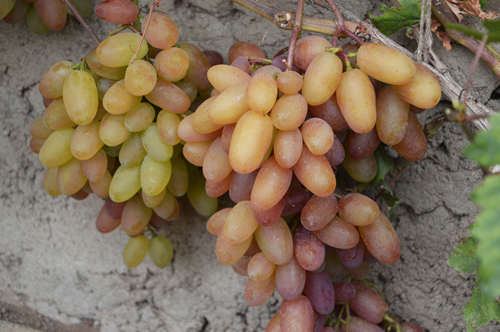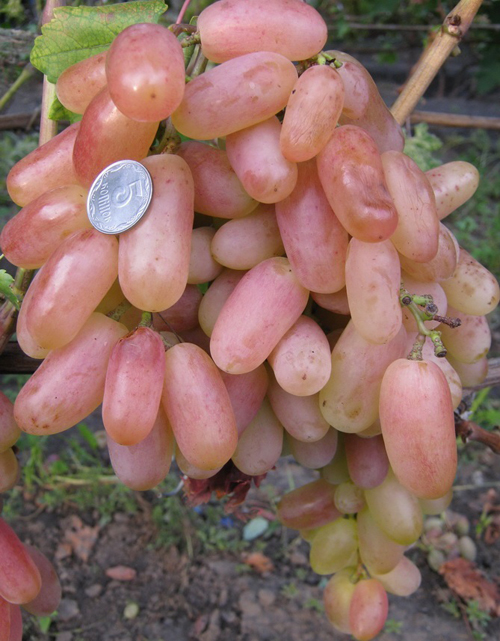Grape variety Anniversary of Novocherkassk
The anniversary of Novocherkassk is one of the most famous hybrid forms of the master-pioneer of folk selection of grapes Viktor Nikolaevich Krainov, whose contribution to the popularization of amateur viticulture in our country can hardly be overestimated.

During his life, Viktor Nikolaevich has created many promising hybrids of various characteristics and appearance, but the famous "Krainov Troika", which includes the Anniversary of Novocherkassk, is beyond praise. In addition to him, the top three also includes “Transformation"And" Victor ". All of them are united by the similarity of ripe bunches in their shapes, color, size and taste characteristics, with certain differences in plant morphology and some minor characteristics. During his lifetime, the breeder did not leave information about what the parental forms of these new varieties were, noting only that they were obtained as a result of complex hybridization. Therefore, today among connoisseurs-winegrowers disputes about this do not subside, however, most of them still agree that all three hybrids descended from the same parents - Mascot and Radiant kishmish, however, each of a separate seed was grown, which ultimately predetermined both a lot of similar properties and certain differences between them. After all, this is often the case in grape breeding, when varieties obtained from the same parents differ from each other, and sometimes very significantly.
In favor of the Talisman as the alleged maternal form, it is said that, due to the functionally female type of flower, it is very convenient for the work of amateur breeders. It is enough to isolate the inflorescence before it blooms, and you can not worry about self-pollination, or cross-pollination with pollen from a variety other than the one the author needs. Radiant Kishmish as a paternal form is indicated by its very specific radiant-pink color of berries, which is repeated in all three representatives of the "troika".
Whatever it was, but the Anniversary of Novocherkassk after its appearance made a splash among buyers. A huge bunch, elegant attractive colors of berries, their beautiful elongated shape and flesh, amazing in consistency and taste, leave no one indifferent. Despite the fact that the variety has been on the market for a long time, interest in it not only does not fade away, but also grows every year, finding loyal admirers, both among winegrowers and among buyers of fresh grapes.

Agrobiological characteristics of the variety
The bushes are vigorous both in grafted and in their own rooted culture. The leaves are large, three- and five-lobed, embossed, strongly dissected, pubescence is absent. The leaf blade is glossy, dark green in color with light green veins. The lateral notches are deep, open, lyre-shaped, with a narrow aperture and a rounded bottom; a petiole notch with parallel sides and a rounded bottom. The denticles at the edges of the leaf are large, triangular with a wide base. The flower is bisexual, does not require additional pollination.
The bunches of grapes are very large (from 700 to 1500 grams or more), conical and cylindro-conical, moderately dense. The crest is powerful, firmly attached to the vine by a medium-long comb. The berries of the Novocherkassk Jubilee are also very large, elongated-oval, with an average length of 38 mm and a diameter of 23 mm. Weight ranges from 12 to 18 grams. There is evidence of the growth of larger specimens. The pulp is very fleshy, juicy, sweet, harmonious in taste, without specific varietal characteristics. The skin is of moderate density, easily edible. Skin color varies depending on climate and weather conditions, from white-pink to yellowish or completely pink. The seeds are present in the berry, but in a large volume of pulp, they are practically not felt when eating.In most cases, there is no tendency to cracking berries, however, extreme changes in soil moisture during the ripening period can negatively affect the quality of the crop. Bunches of grapes can hang on the bushes for a long time after the onset of removable ripeness, but it is necessary to take into account the possibility of damage by wasps, which is moderate in the variety.
The crop is intended for fresh consumption. The advantages of the Novocherkassk Jubilee invariably include high marketability, keeping quality and transportability of bunches, consistently high demand and value in the market.

The variety is characterized by a very early ripening period. Already after 110-115 days of growing season, which in the south corresponds to the first or second decade of August, the berries are already quite ready for consumption. For this, the grapes need only 2400 ° C active temperatures, which makes this variety very valuable for growing in the middle lane and even in relatively northern regions. In the south, they even manage to get two crops per season: the first on ordinary fruit shoots, and the second at the end of the growing season on stepchildren. The bunches of the second collection, however, are significantly smaller in comparison with the standard. The yield is high. From an adult, well-developed bush of the Anniversary of Novocherkassk, it is quite capable of collecting up to 18-20 kilograms of ripe bunches.
The frost resistance of the hybrid reaches -23 ° C. The vine ripens well. The fruitfulness of the shoots is high, however, in order to achieve the best harvest conditions, as in all large-fruited varieties, it is recommended to remove the second and even more so the third clusters on the fruit vines. The sugar-acid ratio in grape juice is harmonious, sugar content is 17%, acidity is about 6 grams per liter.
Agrotechnical features
Novocherkassk's jubilee does not have any special requirements for soil, climate and care, but at the same time it is not completely unpretentious. To obtain a high-quality and large harvest, he needs to receive proper care and protection from pests and diseases.
The hybrid is unstable to phylloxera, and therefore the establishment of plantations in the zones of infection by this pest must be carried out with grafted seedlings. Its fusion with rootstocks, as well as the rooting rate of own-rooted seedlings, is high. Grapes are moderately and weakly resistant to fungal diseases. Protection against them must be carried out in full. Ripe bunches of this variety are affected by wasps, which also requires the attention of the grower.
The formation of the skeleton of the bush should be carried out in relation to the climatic conditions of the growing region. In regions where the frost resistance of the Novocherkassk Jubilee will be sufficient for cultivation in a non-covering culture, powerful standard formations are recommended; if you need shelter for the winter, it is worth choosing fan multi-arm options. The load of shoots and crops must be clearly adjusted depending on the growth force and energy of a particular bush. At the same time, it can vary from 30 to 45 eyes, with a trimming length of 7-9 buds. The feeding area of a bush of this variety should be about 5-6 square meters.
It is necessary to carefully consider the conduct of green operations in the vineyard, first of all, to the removal of excess brushes and shoots, as well as pinching. Insufficient quality and untimely implementation of them threatens with thickening of the grape bush and overloading. This, in turn, will have an extremely negative effect on the quality of the crop, the timing of its ripening, ripening of the vine and its subsequent winter hardiness.
Summing up, we can say that the popularity of the Novocherkassk Jubilee among amateur winegrowers is not based on an empty space, and not even on the attractiveness of the appearance of the bunches. Even despite the low resistance to diseases and pests, this is a very worthy contender to take its place in the personal plot and even in the production vineyard. Grown with caring hands, it will not only delight the eye, but also satisfy the taste needs of the most demanding gourmets.








